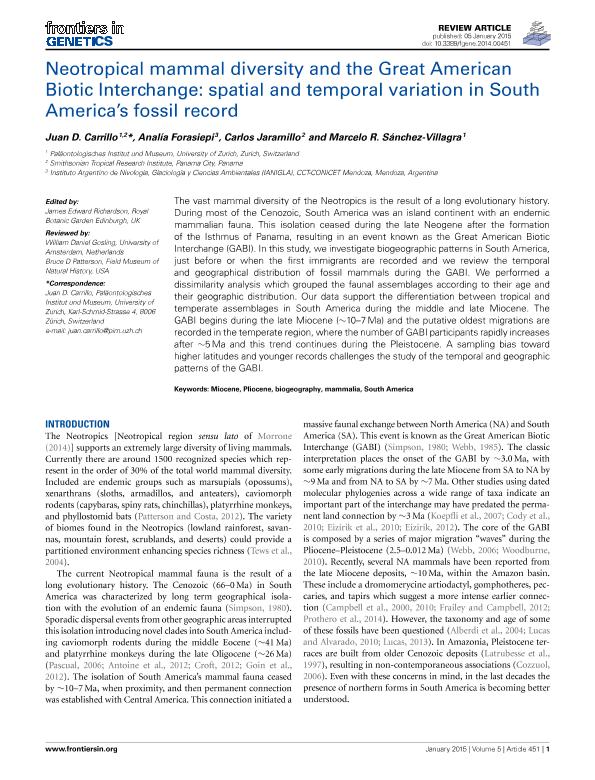Artículo
Neotropical mammal diversity and the great American biotic interchange: Spatial and temporal variation in South America's fossil record
Fecha de publicación:
01/2015
Editorial:
Frontiers Research Foundation
Revista:
Frontiers in Genetics
ISSN:
1664-8021
Idioma:
Inglés
Tipo de recurso:
Artículo publicado
Clasificación temática:
Resumen
The vast mammal diversity of the Neotropics is the result of a long evolutionary history. During most of the Cenozoic, South America was an island continent with an endemic mammalian fauna. This isolation ceased during the late Neogene after the formation of theIsthmus of Panama, resulting in an event known as the Great American Biotic Interchange (GABI). In this study, we investigate biogeographic patterns in South America, just before or when the first immigrants are recorded and we review the temporal and geographical distribution of fossil mammals during the GABI. We performed a dissimilarity analysis which grouped the faunal assemblages according to their age and their geographic distribution. Our data supports the differentiation between tropical and temperate assemblages in South America during the middle and late Miocene. The GABI begins during the late Miocene (~10-7 Ma) and the putative oldest migrations are recorded in the temperate region, where the number of GABI participants rapidly increases after ~5 Ma and this trend continues during the Pleistocene. A sampling bias towards higher latitudes and younger records challenges the study of the temporal and geographic patterns of the GABI.
Archivos asociados
Licencia
Identificadores
Colecciones
Articulos(IANIGLA)
Articulos de INST. ARG. DE NIVOLOGIA, GLACIOLOGIA Y CS. AMBIENT
Articulos de INST. ARG. DE NIVOLOGIA, GLACIOLOGIA Y CS. AMBIENT
Citación
Carrillo, Juan Carlos; Forasiepi, Analia Marta; Jaramillo, Carlos; Sánchez Villagra, Marcelo R.; Neotropical mammal diversity and the great American biotic interchange: Spatial and temporal variation in South America's fossil record; Frontiers Research Foundation; Frontiers in Genetics; 5; DEC; 1-2015; 1-11
Compartir
Altmétricas




